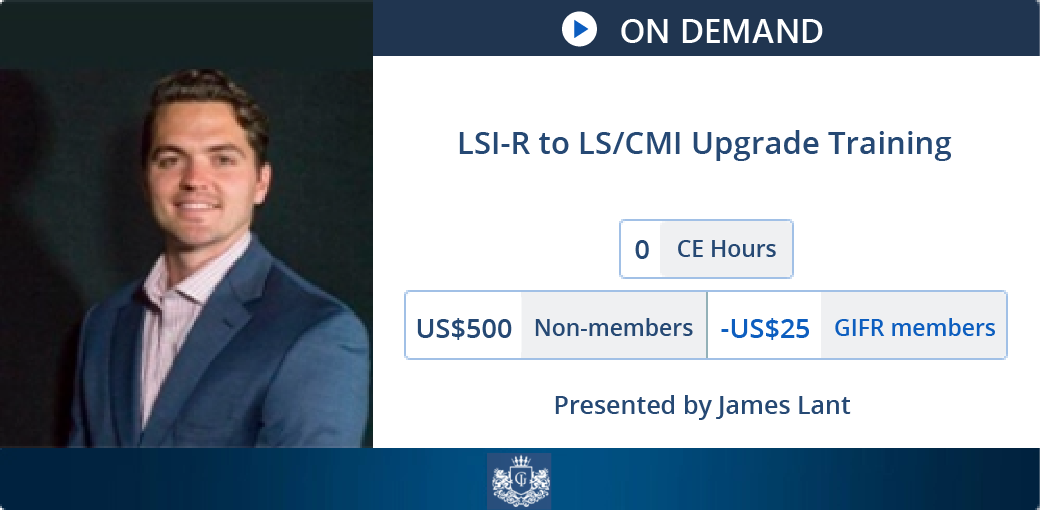 This training has been designed to serve as an upgrade for previously trained LSI-R users to become trained users of the Level of Service/Case Management Inventory (LS/CMI). This fast and efficient training will have your team up to speed on using the LS/CMI tool in no time. More cost-effective and time-efficient than attending an in-person workshop but covering the same content, this innovative training is the first-of-its-kind.
This training has been designed to serve as an upgrade for previously trained LSI-R users to become trained users of the Level of Service/Case Management Inventory (LS/CMI). This fast and efficient training will have your team up to speed on using the LS/CMI tool in no time. More cost-effective and time-efficient than attending an in-person workshop but covering the same content, this innovative training is the first-of-its-kind.
Following the Risk-Need-Responsivity Model of rehabilitation, the LS/CMI™ is a fully functioning case management tool and assessment that measures the risk and need factors empirically associated with recidivism. This tool also focuses on offender strengths, supervision considerations, and aspects pertaining to late adolescent and adult offenders. The LS/CMI™ is a scientifically validated tool that provides an accurate and reliable recidivism risk assessment across gender, ethnicities, and countries.
LSI-R to LS/CMI Upgrade Training consists of the following areas of focus:
- Users are provided with a review of the first five modules of the LS/CMI. You’ll learn about the LS/CMI’s elements, history, and rationale.
- The LS/CMI tool is discussed, including a review of each section in the tool. Principles of Risk, Need, and Responsivity, and Professional Discretion to increase users’ understanding of the importance of structured, validated risk/need assessments will be reviewed.
- Following this, a review of assessment practices is provided, with tips for conducting a valid interview. Despite best efforts, mistakes sometimes occur. We’ll review common assessment mistakes and tips for avoiding them to prevent mistakes. The standardized scoring rules are also reviewed, with an emphasis on common errors.
- The training concludes with a video scoring exercise allowing users to test their understanding of the scoring criteria, a discussion of the scoring, case planning, and some helpful general points to remember.
At the end of this training, you will be able to:
- Describe the Risk-Need-Responsivity Model
- Apply interviewing best practices for the LS/CMI™
- Combine risk assessment and case management in one convenient evidence-based system
- Apply the essential tools needed to aid in treatment planning for and management of clients in justice, forensic, correctional, prevention, and related agencies
- Assess the rehabilitation needs of clients, their risk of recidivism, and the most relevant factors related to supervision and programming requirements
- Identify types of questions that should and should not be used when conducting assessment interviews
- List common assessment mistakes and describe techniques to prevent them
- Explain common scoring mistakes
- Administer the LS/CMI™ in the field
Cost
Individual
Purchase attendance for a single individual
Non-Member Cost
US$500
GIFR Member Cost
– US$25
Group
To be considered a group, 10 or more individuals are required to participate. Purchase attendance for your team, facility, or library.
Why Train With GIFR?
Save Money
Eliminate hidden costs of in-person trainings including travel, hotel, food, and gas
Improve Outcomes
Increase the reliability and accuracy of your recidivism risk/needs assessments using the LS/CMI
Trainer Biography
James M. Lant is the Manager of Integrations and Implementations at Multi-Health Systems Inc. James has worked in the criminal justice space for over 12 years. He has helped both youth and adult agencies adopt risk assessment and case management measures, policies, and procedures all over the world by training staff, building solutions, and distributing technology for these organizations. James has been a Master trainer for all Level of Service tools for 4 years and has presented best practices in offender risk assessment at conferences and universities. From 2017-2020, James served as the Editor-in-Chief of the Violence and Recidivism Executive Bulletin for the Global Institute of Forensic Research (GIFR). The bulletin includes summaries of peer reviewed research articles on Offender Risk/Need assessment from 150 peer-reviewed journals and is sent to 900 subscribers each month.





